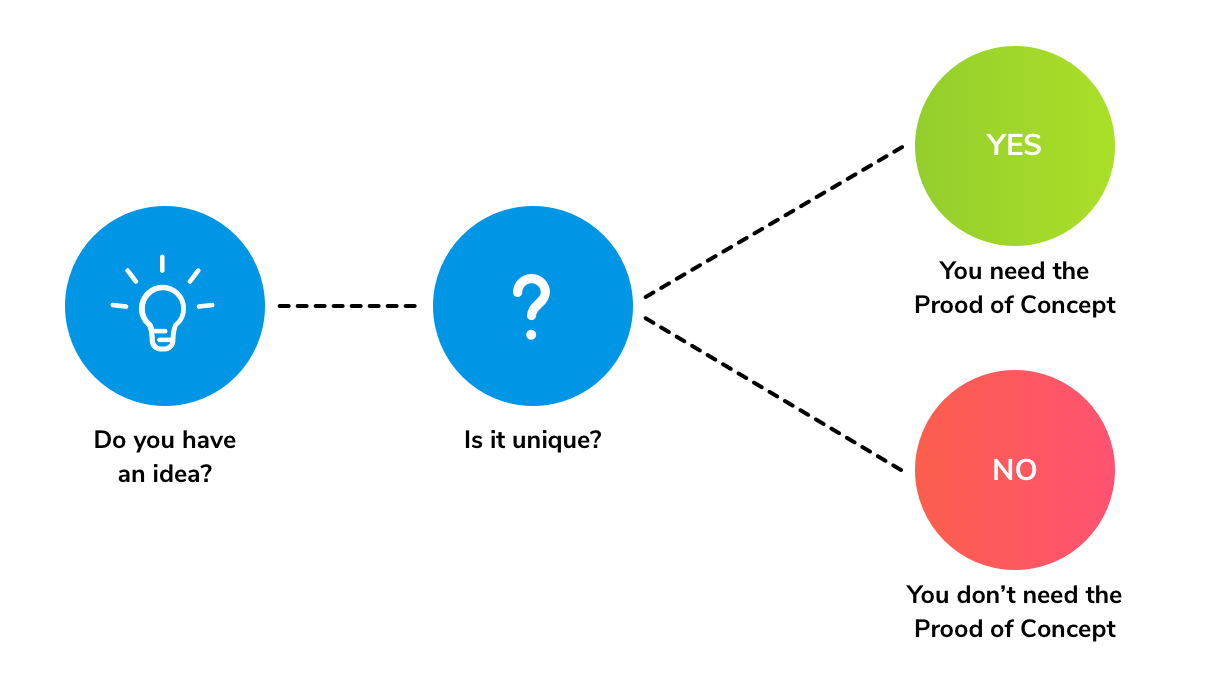Proof of concept vs Prototype
Proof of Concept (aka POC, PoC, or Proof of principle) is a realization of a particular idea or method to demonstrate its feasibility without the necessity of building a complete working solution. It can also be a demonstration in principle to verify that some concept or theory has practical potential. A proof of concept is usually small and may or may not be complete.
In engineering and technology, for example, a working concept of an electrical device may be constructed using a breadboard. A patent application often requires a demonstration of functionality before being filed. Some universities have proof of concept centers to fill the ‘funding gap’ for seed-stage investing and accelerate the commercialization of university innovations.
In software development, PoC aims to determine the solution to some technical problem (such as how two systems/APIs might integrate) or to prove that a given configuration can achieve a specific throughput. Vendors may utilize a PoC to establish whether a system satisfies some aspect of the purpose for which it was designed. Once a vendor is satisfied, a prototype is developed, which is then used to seek funding or demonstrate to prospective customers. Tech demos are designed as a PoC for video game developers. Such PoC can demonstrate graphics or gameplay capabilities crucial for particular games.
In startups and businesses, PoC is a preliminary demonstration to validate that an idea, technology, or business concept is feasible, and has potential value before full-scale development or launch. If you want to see some cool examples of Proof Of Concepts from Tesla, SpaceX, Dropbox, Product Hunt, and others, you can read our article "Proof of Concept for business and startups: why & how?".
Proof of concept vs Prototype
Many people think that Proof of Concept and Prototype mean the same thing. But they are two different concepts with similar goals. A PoC shows whether a product or its function can be developed, while a Prototype shows how it can be developed.
The prototype is focused on product visualization. It shows how the product will look and feel. It is like a draft or a first attempt at making a working model.
The main advantage of a prototype is that you can quickly test it for possible errors. Although you don’t market it, you can get feedback from potential users. Then, based on feedback from testers, designers and developers can quickly make changes to the existing one, release new versions (or create a new prototype).
This solution (compared to full development) saves time and money, helps identify customer needs and errors, and receives feedback at an early stage.
“A Proof of Concept shows whether a product or its function can be developed, while a Prototype shows how it can be developed.”
Proof of Concept checks whether the idea is feasible from a technology perspective, while Prototype focuses on the UX and UI levels. Prototyping allows you to give the product a shape and look and to plan how the user will interact with the application.
The prototyping process uses tools such as wireframes or mockups. UX designers draw the user journey and the schematic appearance of the interface on paper, whiteboard, or in professional software (Sketch, Figma, etc.). After developing the UX, they work on an interactive prototype with UI. It may look like a fully-fledged app, including the ability to scroll views or jump to subsequent screens, but there’s no code behind it. Here is an example of how UX Designers and Interaction Designers at Google prepare a digital prototype:
Moving from Prototype to MVP
Moving from prototyping to a Minimum Viable Product (MVP) involves taking an idea from its conceptual phase to a version that can be released for first users. MVP is already a functional version of the product.
Comparing a prototype to an MVP, we can say that a prototype is like a toy model of a new idea. Imagine a drawing of a toy car to show how it will look or work before making the real thing. An MVP is like making a basic version of that toy car with wheels that actually move, but without any cool colors or fancy features. It’s just enough to see if people like it and want to play with it before adding more details.
MVP should include only the core features necessary to solve the main problem and satisfy early adopters. It’s more developed than a prototype but still not a complete product. MVP aims to enter the market with minimal investment, gather feedback, and learn from real user interactions. The best practice here is to keep it simple. Resist adding non-essential features to the MVP. The simpler, the better for gathering clear feedback. Here you can check our guide to MVP types.
Summary
In simple terms, Proof of Concept is about proving that an idea is possible, while a Prototype is about showing how the idea works in action. Both help turn ideas into real products but serve different steps in the process.
We at molfar.io help entrepreneurs turn ideas into working business. If you need any consultation regarding proof of concept, prototyping, MVP development, or finding product-market fit – feel free to contact us. We are happy to help you.




